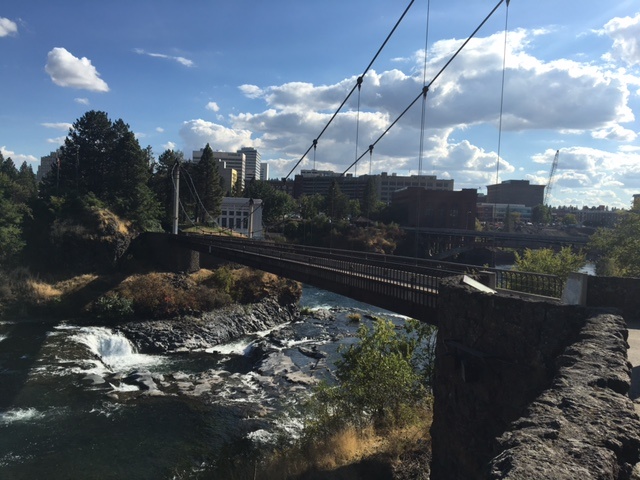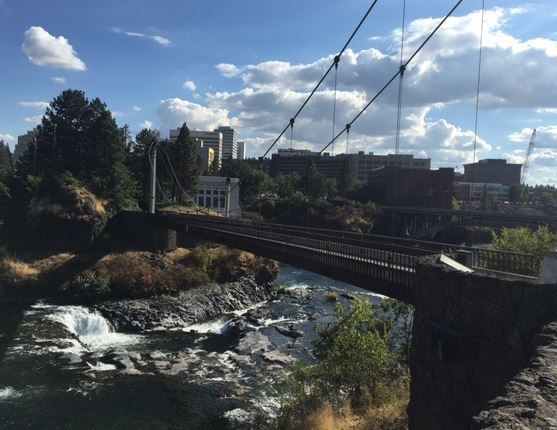|
If you're enjoying receiving this in your inbox every two weeks, consider forwarding it to a friend or colleague so they can sign up too!
Spokane, New Localism, and the 21st Century
I traveled this week to Spokane, Washington to speak at the annual gathering of Greater Spokane Inc. (GSI). It was my first visit to this mid-sized metropolis of 556,000, the 98th largest in the United States.
The main purpose of the visit was to give a preview of The New Localism, my new book with Jeremy Nowak, which will be officially published later this year.
As with most trips, I received a whirlwind tour of the area upon arrival. I was fortunate to have Todd Mielke, the head of GSI, as my guide. Prior to heading GSI, Todd served as a County Commissioner (of Spokane County); he also previously served as a Washington State Representative.
I came away impressed by several attributes of the city and metropolis, which reinforced the central themes in our upcoming book.
Jeremy and I have argued that small and mid-sized metros must invest for the long term and focus intensely on leveraging the special advantages of their communities.
Spokane is doing that on several fronts.
First, the city is renovating Riverfront Park, which now joins my top list for most dramatic downtown vistas in the United States. The 100 acre park was created for the 1974 World’s Fair, replacing old rail lines that once separated the city from the Spokane River. The park has a number of pedestrian bridges which oversee several waterfalls, all walking distance from the core of the downtown. This brings nature into the city in ways that are simultaneously stunning and calming. As you will see from this photo, the “wow” factor is very high. As I said to the GSI gathering, “You had me at the waterfall.”

Second, the city is paying special attention to its geography of innovation. Over the past several decades, the business community led an effort to co-locate a number of university programs and centers (including a medical college) in a 770 acre area near downtown that is aptly called University District. The universities involved include Washington State University, Eastern Washington University, Gonzaga University, Whitworth University, the University of Washington, and the Community Colleges of Spokane. The common focus of these universities is on life sciences to complement the city’s concentration of hospitals and health care services that are located on the city’s South Side.
The co-location of universities near downtown has created a platform for an innovation district that grows companies and acts as a living laboratory. A new collaboration between WSU, Providence Health Care and Empire Health Foundation has already spawned a Spokane Teaching Health Center, and a medical residency program for new doctors. A pedestrian bridge is being built over the BNSF railway tracts to connect the University District with a light industrial area and (further on) the area’s hospitals. The energy and enthusiasm behind this Innovation District in evolution is palpable.
Third, GSI is focusing on growing talent. Significantly, the first stop of my tour with Todd was Spokane Valley Tech, a special high school that focuses on hands-on STEM, computer sciences, manufacturing, and bioengineering in collaboration with GSI and local businesses. As one local leader said during the GSI gathering, Spokane represents “the perfect confluence of industry, innovation and education” and this special school, located in a renovated Rite-Aid establishment, is its physical manifestation.
Finally, the city is seeing a reinvigoration of its local newspaper, The Spokesman-Review, under the editorial leadership of Rob Curley. Curley is a newcomer to Spokane and has an outsider’s appreciation for the city’s many attributes and a sophisticated technologist’s sense of what it will take for local media to survive and thrive today. He also is an admirer of William Allen White, the famed editor of The Emporia Gazette, and has a strong sense of the media’s role in civic life and local democracy. The paper’s ownership by the local Cowles family means that Curley has a shot at doing something exceptional.
One of the main questions that Jeremy and I have received to date about New Localism is whether and how it applies to small and mid-sized cities and metropolitan areas. I came away from Spokane believing that this is a place ready to lead from the bottom-up and be the best 21st century version of itself.
Thanks for reading,
Bruce Katz
Centennial Scholar, The Brookings Institution
Please share thoughts and feedback to my direct email address, bkatz@brookings.edu, and suggest others sign up here.
This email is in your inbox because you've expressed interest in my work. If you decide you’d rather stay connected through other means, feel free to unsubscribe here.
|

